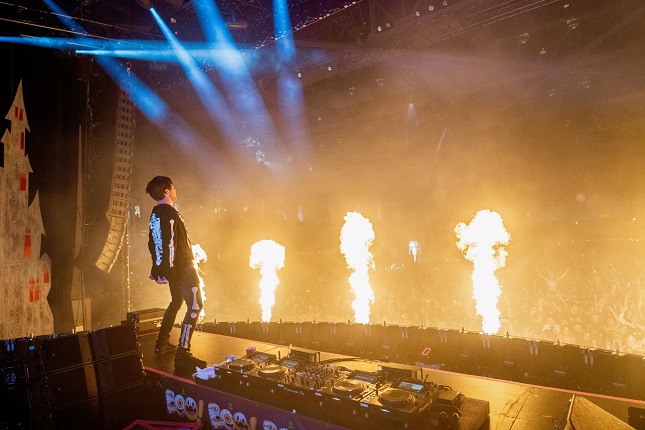In the competitive landscape of trade shows, capturing the attention of attendees and fostering meaningful interactions is very important. These shows have long been a cornerstone for businesses aiming to showcase their products and services, network with industry peers, and capture the attention of potential clients. However, as the trade show environment becomes increasingly saturated, the challenge of standing out and making a lasting impression grows ever more significant. In this context, engaging attendees becomes paramount.
A well-designed trade show booth can serve as more than just a display; it can be an immersive experience that captivates visitors and leaves a lasting impression. One particularly effective way to achieve this is by integrating reward-based activities into your booth design. This approach not only incentivizes attendees to participate and ultimately drives brand awareness and lead generation but also encourages meaningful interactions that can lead to lasting business relationships.
Consider the example of Cisco. Cisco Live is one of the most significant tech events hosted by Cisco Systems, drawing thousands of IT professionals, tech enthusiasts, and business leaders globally. With an audience this large, standing out among the many vendors and creating a memorable experience was crucial for Cisco.
In 2023, Cisco designed a custom trade show booth that was both visually striking and functional. The booth featured multiple interactive zones, each dedicated to a different Cisco solution, such as cybersecurity, networking, and collaboration tools. The booth incorporated several reward-based activities like a gamified learning experience through a “Tech Trivia Challenge,” interactive demos with incentives, and automatic entry into a raffle when people posted the booth on social media with a hashtag to enhance visitor engagement.
Cisco’s booth became one of the busiest at the event, and the immersive experience and the integration of rewards helped reinforce Cisco’s brand in attendees’ minds, resulting in positive post-event feedback and increased brand loyalty.
Continue reading this article to learn the different benefits of custom trade show booths, the advantages of incorporating rewards-based activities, and how to effectively design and execute such a booth.
Benefits of Custom Trade Show Booths
Custom trade show booths offer a range of benefits that standard, off-the-shelf options simply can’t match. They include:
1) Brand Differentiation
A carefully designed custom booth attracts and engages the target audience and reflects your brand’s identity, making it easier to convey your company’s ethos, values, and message to attendees. Though you can design your booth yourself with you and your team, hiring the services of experienced brands like Look Our Way can also help.
2) Flexibility and Adaptability
You design custom booths to meet specific goals, whether it’s product demonstration, customer interaction, or brand awareness. This flexibility ensures that the booth is not only visually appealing but also functional and effective in achieving your objectives.
3) Targeted Messaging
A custom booth allows for targeted messaging that speaks directly to your ideal customer profile. It ensures that your booth attracts the right audience, increasing the chances of converting leads into customers.
4) Enhanced Visitor Experience
A well-thought-out custom booth can offer an immersive experience, making it easier for attendees to engage with your brand. Interactive elements, such as touch screens, virtual reality (VR), or augmented reality (AR), can provide attendees with a hands-on experience, making your booth a destination rather than just a stopover.
Reward-Based Activities: Concept and Advantages
Reward-based activities are a proven strategy to increase engagement at trade shows. These activities incentivize attendees to interact with your brand, which can lead to deeper engagement and a more memorable experience. Some examples include:
- Contests and giveaways: Prizes for completing tasks or answering questions can generate excitement and encourage participation.
- Gamification: Incorporating game elements into the booth experience can make it more fun and engaging for attendees. For example, at the 2021 Consumer Electronics Show (CES), LG Electronics introduced an interactive game at their booth where attendees could play a virtual reality (VR) game to “build” an LG smart home.
Participants who completed the game received exclusive LG-branded merchandise, such as wireless earbuds or smart home discounts. This attracted large crowds and allowed attendees to experience LG’s latest technology firsthand.
- Interactive demos: Providing hands-on experiences with products or services can help attendees better understand their benefits and increase their likelihood of purchasing.
- Loyalty programs: Rewarding repeat attendees fosters long-term relationships and encourages brand loyalty.
- Photo booths: Photo booths with instant rewards are another example. At the 2019 SXSW (South by Southwest) event, Red Bull set up a custom photo booth at their booth. Attendees could take themed photos with Red Bull branding and immediately receive a printed copy along with a small prize, such as a Red Bull can or branded sunglasses.
In addition to the instant gratification, attendees could enter their photos into a contest on social media for a chance to win larger prizes like concert tickets or VIP passes to Red Bull events.
Having discussed examples of ways you can incorporate reward-based activities in your trade show booths, let’s look at some benefits.
1) Increased Booth Traffic
Rewards such as giveaways, prizes, or exclusive discounts will naturally attract more attendees to your booth. People are drawn to the prospect of winning something, which can turn your booth into a high-traffic area. This increase in foot traffic gives you more opportunities to engage with potential customers.
2) Brand Recall and Awareness
Attendees participating in engaging activities and receiving rewards are more likely to remember your brand. This positive association can improve brand recall, making your company stand out long after the trade show has ended.
3) Social Media Amplification
Reward-based activities can be integrated with social media, encouraging participants to share their experiences online. For example, you can offer additional rewards for attendees who post about your booth on social media using a specific hashtag. It increases your booth’s visibility at the event and extends your reach to a broader audience online.
4) Differentiation From Competitors
In a crowded trade show environment, offering unique and engaging reward-based activities can help differentiate your brand from competitors. It positions your company as innovative and customer-focused, which can be a deciding factor for attendees when choosing which booths to visit.
Designing a Custom Booth with Reward-Based Activities
When designing a custom booth that integrates reward-based activities, it’s important to consider aesthetics and functionality. The design should be eye-catching enough to draw in attendees yet practical enough to facilitate the reward-based activities you plan to host. Here are things to be mindful of when designing your booth:
1) Define Your Objectives
Before starting, set clear goals and objectives, clarifying what you want to achieve. Ask yourself:
- What are your primary goals for being present in this show (generating leads, launching a new product, increasing brand awareness)?
- What type of engagement do you want from attendees (product interaction, social media sharing, data collection)?
Having an understanding of your audience is also essential. First, determine who your target attendees are. Are they industry professionals, decision-makers, or tech enthusiasts? Then, try to understand what motivates them (exclusive content, product discounts, branded merchandise) and the activities they’d be interested in (interactive games, quizzes, social media challenges).
2) Design the Space for Interaction and Engagement
Your space should be visually appealing and designed for engagement. Ensure your booth is visually striking with bold colors, dynamic signage, and branded materials. A well-designed booth will naturally attract attention, drawing attendees in to see what you have to offer.
Consider using technology to enhance the interactive experience. Touch screens, tablets, VR/AR setups, or digital kiosks can make your activities more engaging and memorable. For example, a digital prize wheel or a tablet-based quiz can be a fun way to involve attendees.
3) Focus on Flow and Accessibility
Your booth should be easy to navigate, with a layout that guides attendees through different activities without causing congestion. Consider:
- Traffic management: Design your booth with clear pathways and distinct activity zones. This ensures that attendees can move freely without feeling cramped or overwhelmed.
- Accessibility: Make sure all attendees, including those with disabilities, can participate in your activities. This might involve providing alternative ways to engage with digital elements or ensuring that all areas of the booth are accessible.
4) Test and Prepare
Before the trade show, test all booth elements to ensure everything works smoothly. This includes:
- Technology: Ensure all digital elements (tablets, VR headsets, touch screens) function properly.
- Staff Training: Train your staff on how to operate the booth, manage activities, and engage with attendees. They should be familiar with the technology and know how to troubleshoot if any issues arise.
Implementation and Execution
Here’s how to implement and execute everything perfectly so that your booth runs smoothly:
1) Pre-Event Promotion
Start promoting your reward-based activities before the event. Use social media, email marketing, and your website to create buzz. Let attendees know what they can expect and what rewards are up for grabs. This will increase anticipation and drive more traffic to your booth.
2) Staff Training
Your staff should be well-trained to manage the activities and engage with attendees effectively. They should be knowledgeable about the products or services on display and be able to guide attendees through the reward-based activities seamlessly. At the 2023 National Retail Federation (NRF) Show, Amazon trained its staff to use tablets to guide visitors through an interactive quiz on the latest retail technology trends, with top scorers winning Amazon devices.
3) On-Site Management
Ensure that everything is set up well in advance on the event day. Test all technology and ensure all materials, such as brochures, prizes, and registration forms, are readily available. Assign staff to specific roles to avoid confusion and ensure that the activities run smoothly.
4) Real-Time Engagement
Use real-time engagement tools, such as social media and live streaming, to amplify your presence at the event. Encourage attendees to share their experiences online using a custom hashtag. This boosts your brand’s visibility and allows you to engage with a broader audience.
5) Post-Event Follow Up
After the event, follow up with attendees who participated in your reward-based activities. Send them personalized thank-you emails, offer additional incentives, or invite them to future events. This helps to build a relationship that extends beyond the trade show.
Endnote
Custom trade show booths and reward-based activities are powerful for engaging attendees, driving brand awareness, generating leads, and creating a memorable experience that leaves a lasting impression. Don’t forget that innovation and experimentation with new ideas are ways to stay ahead of the competition. Continuously evaluate the effectiveness of your booth and make adjustments as needed to optimize your results.
Remember that creating memorable trade show experiences is an ongoing process that requires dedication, creativity, and a focus on providing value to your target audience. By incorporating custom booths and reward-based activities into your trade show strategy, you can position your brand for success and build lasting relationships with your customers.









































